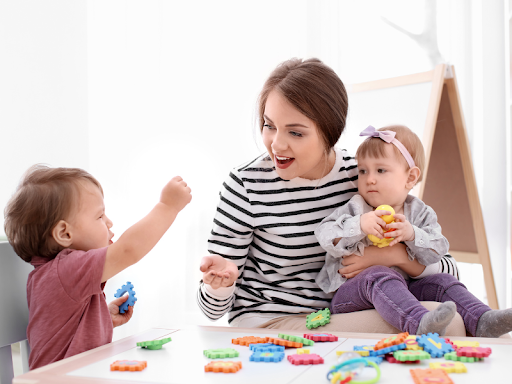Newborn to 3 Years
Basic Needs and Safety: In these tender years, your child’s safety is paramount. Ensure your sitter knows your baby’s feeding schedule, including any allergies and preferences. If your child is still in diapers, provide clear instructions on changing routines. Crucially, leave emergency contact information, including your pediatrician’s number, and discuss any medical information that may be pertinent.
For safety within the home, remind your sitter about baby-proofing measures, such as keeping small objects out of reach and ensuring that baby gates are closed.
Activities and Engagement: At this age, engagement through simple, age-appropriate toys and interactive play is vital. Guide your sitter on your baby’s favorite activities and toys. Supervised playtime is not just fun but essential for your child’s development.
Screen Time Recommendations: The American Academy of Pediatrics suggests avoiding screen time for children younger than 18 months, except for video chatting. For older toddlers, if you choose to introduce digital media, ensure it’s high-quality and use it together with your child to encourage interaction and learning.
Bedtime Routine: Babies and toddlers thrive on routine. Share your child’s sleep schedule and any rituals that help them settle, like a specific lullaby or bedtime story.
Other Considerations: Every child is unique. Share any specific details that help soothe your baby, like a particular pacifier, blanket, or cuddly toy.
Ages 4 to 9
Basic Needs and Safety: Children in this age group are more independent but still need guidance. Provide clear instructions regarding meals and snacks, including what they can prepare themselves. If your child needs medication, leave detailed instructions. Discuss home safety rules, like not opening the door for strangers.
Activities and Engagement: Suggest activities that are both fun and educational. Crafts, simple board games, and outdoor play are great for this age group. Ensure your sitter knows about supervising outdoor play, especially if you have a pool.
Screen Time Guidelines: Set clear limits on screen time and the type of content allowed. Encourage activities that don’t involve screens, like reading or arts and crafts.
Bedtime Routine: A consistent bedtime is crucial for school-aged children. Share your child’s bedtime routine, including any specific rituals like story reading or a nightlight.
Other Considerations: Discuss how to handle any behavioral issues and provide guidelines for pet care if applicable.
Ages 10-13
Basic Needs and Safety: Preteens are increasingly self-reliant. Discuss meal preparation and any allergies or medical needs. Share home security information, like alarm codes, and set rules for answering phones or doors.
Activities and Engagement: Encourage your sitter to support your child’s independence in choosing activities. However, guidelines for playing outside or with friends should be clear.
Screen Time and Digital Safety: Balance screen time with other activities. Discuss internet safety and the importance of privacy.
Bedtime and Personal Space: Respect your preteen’s growing need for personal space while maintaining a consistent bedtime on school nights.
Other Considerations: Set rules for having friends over and discuss how to handle emergencies, like a power outage.










